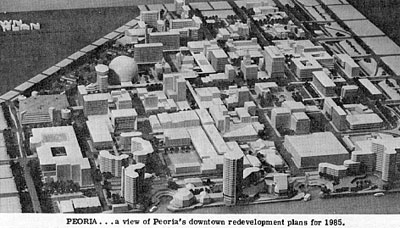I have here Peoria’s City Directory from 1977 (don’t ask me why), and I thought you might enjoy some of the descriptions and predictions of Peoria from 28 years ago:
Population: 134,000
Area: 40 square miles
Parks: 7,000 acres
Airport: City is served by Ozark Air Lines, Continental Airlines, and chartered service by Byerly Aviation Company.
“By number of employees, Peoria’s five major industries are the Caterpillar Tractor Co., Pabst Brewing Co., Westinghouse Air Brake Co., Keystone Consolidated Industries Inc., and Hiram Walker & Sons, Inc.
“Peoria Water Co., in 1976 completed a $3.7 million addition to its Illinois River station that will increase water production capacity by 10 million gallons per day.
“Illinois Bell Telephone Co., in late 1977, will be installing a traffic service position system (T.S.P.S.) which is an electronic computer like system for handling long distance calls.”
And downtown was a hot topic then like it is today:

Peoria is looking to the future with a comprehensive plan to redevelop the Central Business District. The distinguished Washington (D. C.) architect and urban designer, Angelos C. Demetriou, AIA, was hired to create a downtown plan for Peoria and do a feasibility study of its long cherished dream of a Civic Center. The Demetriou Plan for downtown Peoria revolves around two key concepts: the mini-mall to spark retail shopping and the development of the riverfront to attract a 24-hour a day lifestyle in the Central Business District.
The Downtown Plan, developed by a team of consultants led by Angelos Demetriou, is tailored for Peoria. The document begins by building on the existing strengths largely provided by the over $70 million in downtown investment which occurred over the past 15 years. Integrated with the results of those 15 years of accomplishment are new projects which will broaden downtown’s base and which will make it possible to reach new potential for growth identified in the Plan.
The Plan outlines several major elements of change for the downtown.
They include: Housing about 2,550 units downtown; a civic center complex serving three important functions: a convention-oriented exposition hall with 20,000 sq. ft., an auditorium for the performing arts, and a sports arena-assembly hall. Also, new hotels to support the civic center; an enclosed shopping mall to strengthen the retail core; new offices for government, large firms and general occupancy; extensive beautification and improvement of riverfront; and convention parking which is so essential to downtown revitalization.
Considerable activity is underway for implementing the Plan.
The $6.4 million Peoria School of Medicine was opened in 1976 and its medical students are now undergoing training at the various hospital complexes located in the Peoria area.
Downtown received another boost when Cohen Furniture Company completed a major renovation of the “flagship” store at Harrison and Adams.
Final construction drawings are being prepared for the open air plaza on Fulton, between Jefferson and Adams, and renovation of the existing Jefferson Building in downtown Peoria. The plaza would connect the civic center activities in the “superblock” with the enclosed shopping mall between Bergner’s and Sears. The City has not yet proposed a financial plan to pay for this improvement. However, with a feasible financial plan, the project could move very quickly.
The county and city are negotiating for a new city-county administration building. The building would be located at Hamilton, between Adams and Jefferson, across from the Courthouse Plaza. The city has allocated revenue sharing funds toward the project and acquiring the property for the development.
The Peoria Downtown Development Council has been working closely with the City of Peoria and the U. S. Postal Service in the location of a regional Post Office in Peoria. The building will be constructed on about 10 acres of large blighted property on the southern edge of downtown. Also, the city and county have been discussing the issue of building a new jail. The site has not been finalized, however, it will be a common shared facility of the county and city.
These public projects will offer important contributions to downtown and help created the needed environment for major private investments to occur.
Well, that certainly sounds exciting, doesn’t it! It’s not quite the same as DPZ’s Heart of Peoria Plan, but there are a few overlaps: they both agree that retail is vital to downtown (Demetriou recommended building a mini-mall downtown; DPZ said the Shoppes at Grand Prairie should have been built downtown), that there should be more housing options downtown so people can live there, and that your downtown should “attract a 24-hour a day lifestyle.”
I’m actually quite amazed at how much of Demetriou’s plan was realized. The civic center was the biggest thing, of course. Unfortunately, the biggest departure from this plan is the retail aspect. In 1977 there were still several department stores downtown: Bergners, Sears, Sparr, Szolds, and Woolworth. Not only did Demetriou’s mini-mall idea never materialize, but the existing retail stores disappeared as well.
This does answer one question I’ve had for a long time: what was the purpose of Fulton Plaza? It was to connect the Civic Center to the retail shopping “superblock.” Now that Bergners has been replaced with One Technology Parking Deck and the other stores are gone, one wonders why we don’t tear the plaza out and make Fulton a through street again.
In 2033, when we look back at the Heart of Peoria Plan and Vision 2020, I wonder which things will have been implemented and which ones will have fallen by the wayside. I have a feeling there still won’t be any retail downtown, and we’ll probably have hired a new consultant to tell us pretty much the same thing the last two have told us….
